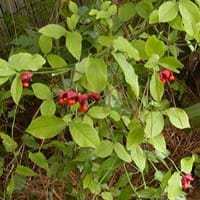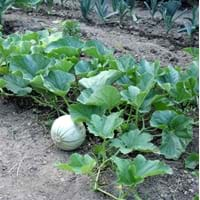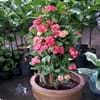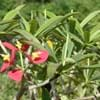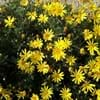Life Span
Perennial
Annual
Origin
Northeastern United States, Mid-Atlantic United States, Southeastern United States, South-Central United States
Hybrid origin, Africa
Types
Not Available
Not Available
Habitat
Shady Edge, Woodland Garden Dappled Shade
along watercourse, Banks, Barren waste areas
USDA Hardiness Zone
6-8
Not Available
Sunset Zone
3b, 4, 5, 6, 7, 8, 9, 14, 15, 16, 17
2a, 2b, 3a, 3b, 4, 5, 6, 7, 8, 9, 10, 11, 12, 13, 14, 15, 16, 17, 18, 19, 20, 21, 22, 23, 24
Habit
Upright/Erect
Prostrate/Trailing
Flower Color
White, Ivory
Yellow
Flower Color Modifier
Not Available
Bicolor
Fruit Color
Magenta, Orange, Red
Green, Yellow green
Leaf Color in Spring
Green
Green
Leaf Color in Summer
Green
Green
Leaf Color in Fall
Yellow, Red, Burgundy
Green, Yellow green
Leaf Color in Winter
Not Available
Light Green
Leaf Shape
Lance shaped
Heart-shaped
Plant Season
Fall, Winter
Summer, Fall
Sunlight
Full Sun, Partial Sun, Partial shade, Full Shade
Full Sun
Growth Rate
Medium
Very Fast
Type of Soil
Clay, Loam
Loam
The pH of Soil
Acidic, Neutral
Neutral
Soil Drainage
Well drained
Well drained
Bloom Time
Early Summer
Early Summer, Summer, Indeterminate
Tolerances
Drought
Drought
Where to Plant?
Ground, Pot
Ground
How to Plant?
Seedlings, Semi-hardwood cuttings
Seedlings
Plant Maintenance
Medium
Medium
Watering Requirements
Average Water Needs, Do Not over Water
Reduce watering once fruit are growing, Water in the early morning hours
In Summer
Lots of watering
Lots of watering
In Spring
Moderate
Moderate
In Winter
Average Water
Average Water
Soil pH
Acidic, Neutral
Neutral
Soil Type
Clay, Loam
Loam
Soil Drainage Capacity
Well drained
Well drained
Sun Exposure
Full Sun, Partial Sun, Partial shade, Full Shade
Full Sun
Pruning
Remove damaged leaves, Remove dead branches, Remove dead leaves
Remove damaged leaves, Remove dead branches, Remove dead leaves
Fertilizers
All-Purpose Liquid Fertilizer
All-Purpose Liquid Fertilizer
Pests and Diseases
Red blotch
Aphids, Cucumber beetles, Fusarium wilt
Plant Tolerance
Drought
Drought
Flowers
Insignificant
Showy
Flower Petal Number
Single
Single
Foliage Texture
Medium
Coarse
Foliage Sheen
Matte
Matte
Attracts
Birds, Deers
Ants
Allergy
Diarrhea, poisonous if ingested
Dizziness, Mouth itching, Nausea
Aesthetic Uses
Not Used For Aesthetic Purpose
Not Used For Aesthetic Purpose
Beauty Benefits
Not Available
Good for skin, Hair Conditioner, Stops hair loss
Environmental Uses
Air purification
Air purification
Medicinal Uses
constipation, Liver problems, Malaria, Tonic
Antitussive, Digestive, Diuretic, Emetic, Febrifuge, Stomachic
Part of Plant Used
Bark, Root, Seeds
Fruits, Seeds
Other Uses
The powdered bark is believed to eliminate dandruff, Used to make tea in cases of uterine prolapse, vomiting of blood
For making oil for cosmetics
Used As Indoor Plant
No
No
Used As Outdoor Plant
Yes
Yes
Garden Design
Mixed Border
Edible, Fruit / Fruit Tree, Herb / Vegetable, Vine
Botanical Name
EUONYMUS americanus
CUCUMIS melo 'Burpees Early Hybrid'
Common Name
Strawberry bush, American strawberry bush, Bursting-heart
Crenshaw Melon
In Hindi
Strawberry Bush
खरबूजा
In German
Strawberry Bush
Zuckermelone
In French
Strawberry Bush
Melon
In Spanish
Fresa Bush
Crenshaw Melon
In Greek
φράουλα Μπους
Crenshaw Melon
In Portuguese
Morango de Bush
Crenshaw Melon
In Polish
Strawberry Bush
Crenshaw Melon
In Latin
Classic Bush
Crenshaw Melon
Phylum
Magnoliophyta
Magnoliophyta
Class
Magnoliopsida
Magnoliopsida
Order
Celastrales
Cucurbitales
Family
Celastraceae
Cucurbitaceae
Clade
Angiosperms, Eudicots, Rosids
Angiosperms, Eudicots, Rosids
Tribe
Not Available
Not Available
Subfamily
Celastroideae
Not Available
Number of Species
Not Available
Not Available
Season and Care of Strawberry Bush and Crenshaw Melon
Season and care of Strawberry Bush and Crenshaw Melon is important to know. While considering everything about Strawberry Bush and Crenshaw Melon Care, growing season is an essential factor. Strawberry Bush season is Fall and Winter and Crenshaw Melon season is Fall and Winter. The type of soil for Strawberry Bush is Clay, Loam and for Crenshaw Melon is Loam while the PH of soil for Strawberry Bush is Acidic, Neutral and for Crenshaw Melon is Neutral.
Strawberry Bush and Crenshaw Melon Physical Information
Strawberry Bush and Crenshaw Melon physical information is very important for comparison. Strawberry Bush height is 90.00 cm and width 90.00 cm whereas Crenshaw Melon height is 30.50 cm and width 120.00 cm. The color specification of Strawberry Bush and Crenshaw Melon are as follows:
Strawberry Bush flower color: White and Ivory
Strawberry Bush leaf color: Green
Crenshaw Melon flower color: Yellow
- Crenshaw Melon leaf color: Green
Care of Strawberry Bush and Crenshaw Melon
Care of Strawberry Bush and Crenshaw Melon include pruning, fertilizers, watering etc. Strawberry Bush pruning is done Remove damaged leaves, Remove dead branches and Remove dead leaves and Crenshaw Melon pruning is done Remove damaged leaves, Remove dead branches and Remove dead leaves. In summer Strawberry Bush needs Lots of watering and in winter, it needs Average Water. Whereas, in summer Crenshaw Melon needs Lots of watering and in winter, it needs Average Water.
